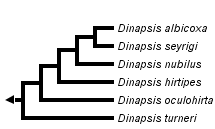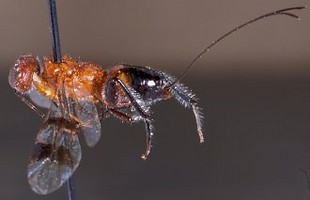Dinapsis
Scott Richard Shaw


This tree diagram shows the relationships between several groups of organisms.
The root of the current tree connects the organisms featured in this tree to their containing group and the rest of the Tree of Life. The basal branching point in the tree represents the ancestor of the other groups in the tree. This ancestor diversified over time into several descendent subgroups, which are represented as internal nodes and terminal taxa to the right.

You can click on the root to travel down the Tree of Life all the way to the root of all Life, and you can click on the names of descendent subgroups to travel up the Tree of Life all the way to individual species.
For more information on ToL tree formatting, please see Interpreting the Tree or Classification. To learn more about phylogenetic trees, please visit our Phylogenetic Biology pages.
close boxIntroduction
Dinapsis is known only from the southern Afrotropical region. For many years the genus was known only by the type-species, Dinapsis turneri, described by Waterston (1922) from a single specimen collected in South Africa (Cape Province). Hedqvist (1967) described an additional five new species of Dinapsis (Shaw 1990b). Recent collections from Madagascar by a research team from the California Academy of Sciences has yielded specimens of at least 17 additional undescribed species. The biology of Dinapsis is not known, but these wasps have been successfully collected by Malaise traps and yellow pans placed in areas of primary forest. The genus is currently being revised by the author.
Characteristics
Dinapsis species are small wasps ranging from 2.5 to 4.5 mm in length. Males are distinctly smaller than females. Some species are black or brown, while others are orange or reddish brown with bright yellow or white markings. Synapomorphies for Dinapsis species include the distinctive coloration of the antenna, the unusual form of the fore wing venation, and the distictive pattern of propodeal sculpture. The antennal flagellum is banded with a white annulus (ring). The radial sector of the fore wing curves abruptly towards the anterior wing margin, forming a short and distictive marginal cell. The propodeum is strongly sculptured with several parallel longitudinal carinae (ridges), and variable numbers of transverse (cross) carinae.
Discussion of Phylogenetic Relationships
The genus Dinapsis is the sister-group to the Oriental genus Ettchellsia (Shaw, 1990b). The arrangement of species given here is based on an analysis of 26 external morphological characters (Shaw, unpublished data). It should be kept in mind that this is only a preliminary framework for understanding dinapsine diversity based on the species named so far (there are at least 17 undescribed species from Madagascar, not yet included in this tree). Two aspects are worth mentioning. First, the South African species, D. turneri, appears to be the most basal lineage in the genus. Second, the Madagascar species appear to comprise a monophyletic group that is hyperdiverse in that area.
References
Hedqvist, K.V. 1967. Notes on Megalyridae [Hym. Ichneumonoidea] and description of new species from Madagascar. Annal. Soc. ent. Fr. (N.S.) 3:239-246.
Shaw, S. R. 1990b. Phylogeny and biogeography of the parasitoid wasp family Megalyridae (Hymenoptera). Journal of Biogeography 17:569-581.
Waterston, J. 1922. A new family of Hymenoptera from South Africa. Annals and Magazine of Natural History (9)10:418-420.
Information on the Internet
- waspweb: Dinapsis. Museums Online South Africa.
Title Illustrations

| Scientific Name | Dinapsis species |
|---|---|
| Location | (Madagascar) in Natural History Museum, Paris |
| Specimen Condition | Dead Specimen |
| Identified By | S. R. Shaw |
| Life Cycle Stage | adult |
| Copyright | © 2005 Simon van Noort |
About This Page
Scott Richard Shaw

University of Wyoming, Laramie, Wyoming, USA
Correspondence regarding this page should be directed to Scott Richard Shaw at
Page copyright © 2005 Scott Richard Shaw
All Rights Reserved.
- First online 18 February 2005
Citing this page:
Shaw, Scott Richard. 2005. Dinapsis. Version 18 February 2005 (under construction). http://tolweb.org/Dinapsis/28845/2005.02.18 in The Tree of Life Web Project, http://tolweb.org/







 Go to quick links
Go to quick search
Go to navigation for this section of the ToL site
Go to detailed links for the ToL site
Go to quick links
Go to quick search
Go to navigation for this section of the ToL site
Go to detailed links for the ToL site